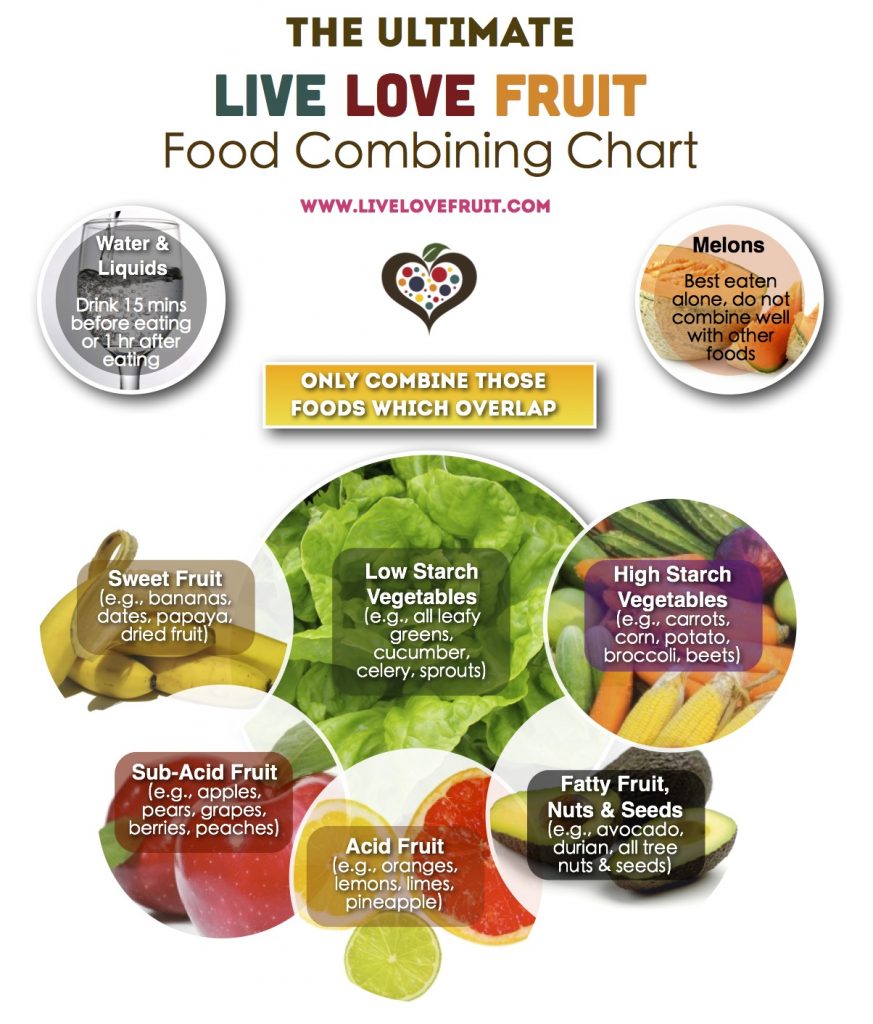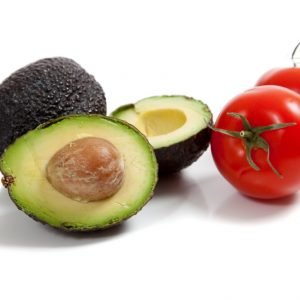
Learning how to properly food combine is incredibly important, especially if you are trying to get rid of bloating and to improve your digestion.
As soon as I started to properly combine foods, my irritable bowel syndrome (IBS) disappeared and that is what got me hooked (I also believe raw living foods helped me get rid of IBS, because there are more enzymes present in uncooked food which helps support your gut, and helps to achieve healthy flora).
If you are combining too many different foods at once, then slower digesting foods may get in the way of faster-digesting foods and can cause problems with fermentation which leads to gas and bloating.
Eating two foods that have different, or opposite digestive needs, the digestive juices become confused because they are trying to meet the requirements and adjust to the pH of those foods at the same time (which is nearly impossible).
The nourishment our bodies receive is determined by what we digest and assimilate, not simply by what we eat.
Certain combinations of foods may be digested much easier and allow us to assimilate the nutrients faster, than other food combinations.
Learning how to properly combine your food will help improve your health by removing digestive distress. It is even noted by many individuals who start combining their food properly that their “food allergies” disappear.
Fermentation is also an issue with combining the wrong foods; properly combining your foods relieves this fermentation which then relieves indigestion and heartburn.
How to Properly Food Combine
Below is a quick guide to help you learn how to properly combine your fruit and vegetables and return yourself to a state of health and wellness:
Water & Liquids:
Drink 15-20 minutes before a meal, or drink 1-2 hours after eating a meal
Melons: (e.g., watermelon, cantaloupe, honeydew, santa claus melon, etc.)
Best eaten alone, do not combine well with other foods (digest very quickly – if you eat melon, be sure to eat it in the morning on an empty stomach). Melons are more than 90% liquid, and leave the stomach quickly if they are not backed up and fermented by combining with other foods, or slower-digesting foods eaten later in the day.
Sweet Fruit: (e.g., bananas, dates, papaya, all dried fruit, figs, jackfruit, mamey sapote, longan, mangosteen, persimmon, sapote)
Combine well with most sub-acid fruits and low-starch vegetables (particularly cucumber, celery and light leafy greens; I would not combine sweet fruit with anything more than these low-starch vegetables). Do not combine well with acid fruit, fats, or high starch vegetables.
Sub-Acid Fruit: (e.g., apples, blackberries, blueberries, raspberries, cherimoya, cherries, grapes, loquat, lychee, mango, nectarine, peach, pear, plum)
Combine well with sweet fruit, acid fruit and low-starch vegetables. Do not combine with more than one other fruit at a time (for example, don’t eat sub-acid fruit with sweet fruit AND acid fruit, just eat sub-acid fruit with sweet fruit, or sub-acid fruit with acid fruit; e.g., eat a pear with papaya, or eat a pear with an orange, but don’t eat a pear with a papaya with an orange, because the papaya and orange will ferment)
Acid Fruit: (e.g., cranberries, grapefruit, kiwi, strawberries, kumquat, lemons, limes, oranges, pineapple, pomegranate, tangerine, tomato)
Acid fruits combine well with sub-acid fruit and low-starch vegetables (as well as some higher starch vegetables; this mainly applies to tomatoes), as well as fatty fruits, nuts and seeds. Do not combine acid fruit with sweet fruit!
Fatty Fruit, Nuts & Seeds: (e.g., avocado, durian, olives, all tree nuts like pistachios, walnuts, almonds, macadamia nuts, cashews, and seeds like hemp seeds, sunflower seeds, pumpkin seeds, and chia seeds)
Combine well with low-starch vegetables and high-starch vegetables as well as acid fruit. Do not eat more than one fat at a time. For example, don’t eat avocado and nuts, since these proteins digest at different rates. Fats combine very well with simple leafy green salads!
High Starch Vegetables: (e.g., carrots, beets, peas, winter squashes (acorn, butternut), water chestnuts, parsnips, potatoes, sweet potatoes, corn, plantains, broccoli, cauliflower)
These vegetables can be eaten with fats, and low-starch vegetables, however I wouldn’t suggest eating them with more than one fat at a time. For example, I would not eat an avocado, nuts and a potato, but avocado and potato are fine.
Low Starch Vegetables: (e.g., sprouts, leafy greens, hearty greens (kale, collards), herbs, bok choy, celery, radishes, sea vegetables, mushrooms, cabbage, jicama, asparagus, okra, cucumbers, green beans and wax beans, fennel, peppers, zucchini, green onions, eggplant, celery, onions, leeks)
These vegetables combine very well with all of the previously mentioned fruit and vegetables. Always remember that the simpler the meal, the simpler the digestion. Keep your meals under 6 ingredients to allow the body to digest the foods properly and assimilate all the available nutrients.
Click the chart below to print out a larger version for your kitchen!









Can i eat for breakfast pineapple with almonds? someone said the is not good because the fat from almonds is deposited while the energy is from the pineapple
I generally don’t recommend fruit with fat.
That is correct. As the body is trying to the deliver the simple carbs to our cells, muscle tissue, brain in order to utilize; the fat from nuts with impede this process causing blood sugar to remain high way longer. This overtime will take a toll on the body (hyperglycemia ,diabetes, etc)
I could not find the chart to print out on this page.
Please direct.
Thank you!
Sorry about that Shannon – should be fixed now!
Hello, I can’t find the chart either.
The chart is at the bottom of the article, you just have to let it load (it’s a large file). You can click on it once it’s done loading.
Thanks for your quick response. I tried again and re-loaded the page but there is nothing. I waited and waited to get sure every single picture on this page was opened. There is nothing. It does say “click the chart below to print out…..” but there is nothing to click on. There is no chart or anything else, just pictures of other articles.
That is really odd Belinda, I am not sure why it isn’t working for you. I tried on my phone, my tablet, my computer on every browser, as well as my partners computer and sisters computer, and the image comes up. Maybe a direct link would work better. Try this: https://livelovefruit.com/wp-content/uploads/2013/07/food-combining-1.jpg
Thanks so much for all that effort you put into trying to find out why I can’t see your chart! This is really weird…..
Your link works for me, I’ve got your chart now. Thanks so much!!
Thanks for letting me know Belinda – and yes, it is really odd you can’t see it, but glad you got it! 🙂
How long should you wait to consume sweet fruits like bananas after having citrus? Thanks.
I would probably wait about an hour.